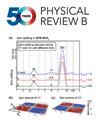在 IBM Q 量子处理器上直接探测量子态的拓扑结构和几何形状
IF 3.7
2区 物理与天体物理
Q1 Physics and Astronomy
引用次数: 0
摘要
拓扑和几何的概念对于探索量子物质的奇异相位至关重要。尽管人们已经在各种实验平台上对它们进行了研究,但迄今为止,即使是对最小模型而言,在通用量子计算机上直接探测拓扑和几何特性仍然是徒劳的。在这项工作中,我们首先展示了量子几何张量(QGT)的密度矩阵形式可以通过量子电路上的保利算子测量明确地重建。然后,我们提出了两种适合 IBM 量子计算机直接探测 QGT 的算法。第一种算法是一种变分量子算法,特别适用于嘈杂的中等规模量子时代设备,而第二种算法则是一种基于量子虚时间演化的纯量子算法。本文介绍并分析了 IBM Q 模拟切尔绝缘体模型得到的明确结果。我们的结果表明,基于跨蒙量子比特的通用量子计算机具有直接模拟和研究量子系统拓扑和几何特性的潜力。本文章由计算机程序翻译,如有差异,请以英文原文为准。
Direct probe of topology and geometry of quantum states on the IBM Q quantum processor
The concepts of topology and geometry are of critical importance in exploring exotic phases of quantum matter. Although they have been investigated on various experimental platforms, to date a direct probe of the topological and geometric properties on a universal quantum computer even for a minimum model is still in vain. In this work, we first show that a density matrix form of the quantum geometric tensor (QGT) can be explicitly reconstructed from Pauli operator measurements on a quantum circuit. We then propose two algorithms suitable for IBM quantum computers to directly probe QGT. The first algorithm is a variational quantum algorithm particularly suitable for noisy intermediate-scale quantum era devices, whereas the second one is a pure quantum algorithm based on quantum imaginary time evolution. Explicit results obtained from IBM Q simulating a Chern insulator model are presented and analyzed. Our results indicate that transmon qubit-based universal quantum computers have the potential to directly simulate and investigate topological and geometric properties of a quantum system.
求助全文
通过发布文献求助,成功后即可免费获取论文全文。
去求助
来源期刊

Physical Review B
物理-物理:凝聚态物理
CiteScore
6.70
自引率
32.40%
发文量
0
审稿时长
3.0 months
期刊介绍:
Physical Review B (PRB) is the world’s largest dedicated physics journal, publishing approximately 100 new, high-quality papers each week. The most highly cited journal in condensed matter physics, PRB provides outstanding depth and breadth of coverage, combined with unrivaled context and background for ongoing research by scientists worldwide.
PRB covers the full range of condensed matter, materials physics, and related subfields, including:
-Structure and phase transitions
-Ferroelectrics and multiferroics
-Disordered systems and alloys
-Magnetism
-Superconductivity
-Electronic structure, photonics, and metamaterials
-Semiconductors and mesoscopic systems
-Surfaces, nanoscience, and two-dimensional materials
-Topological states of matter
 求助内容:
求助内容: 应助结果提醒方式:
应助结果提醒方式:


